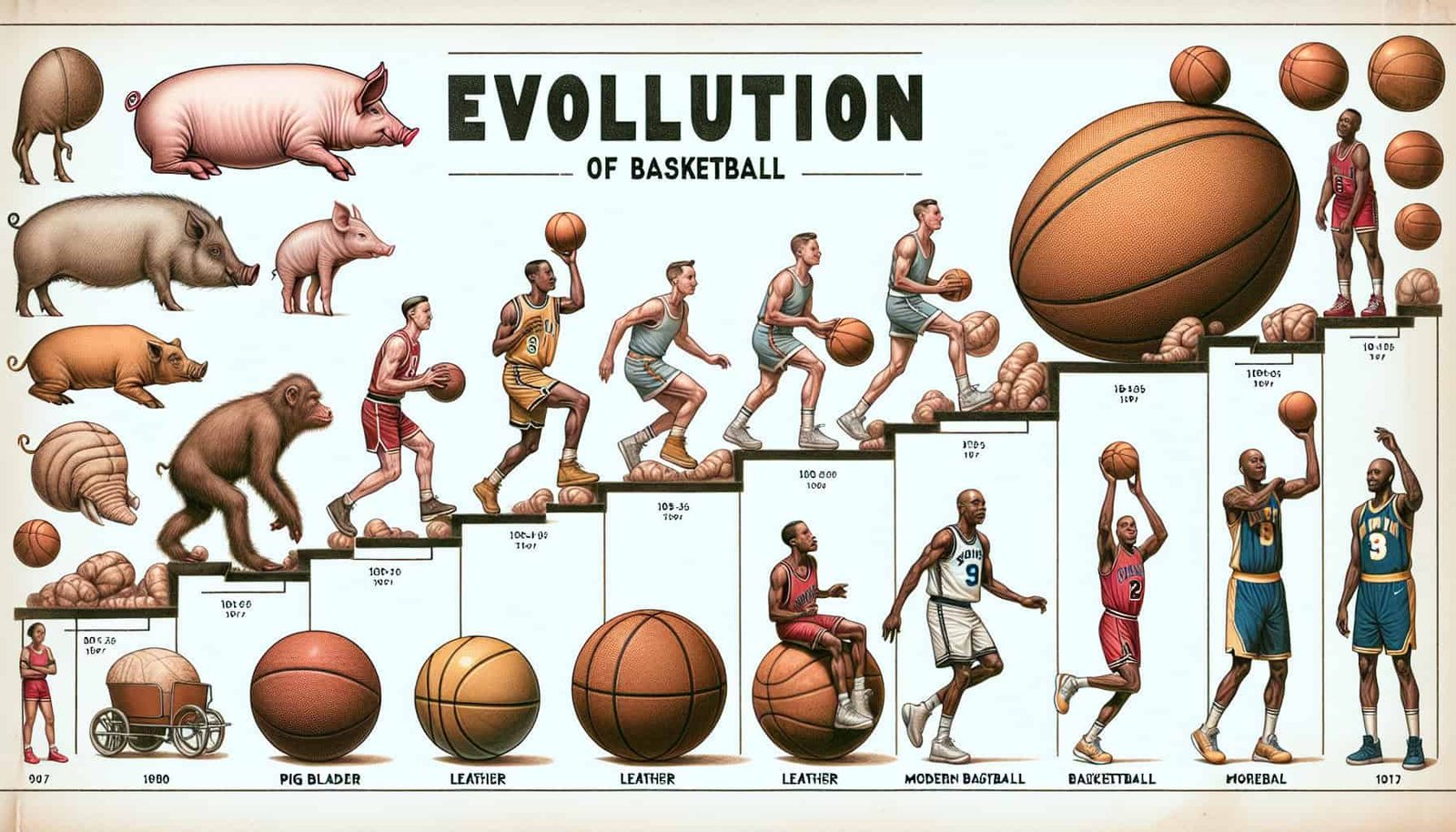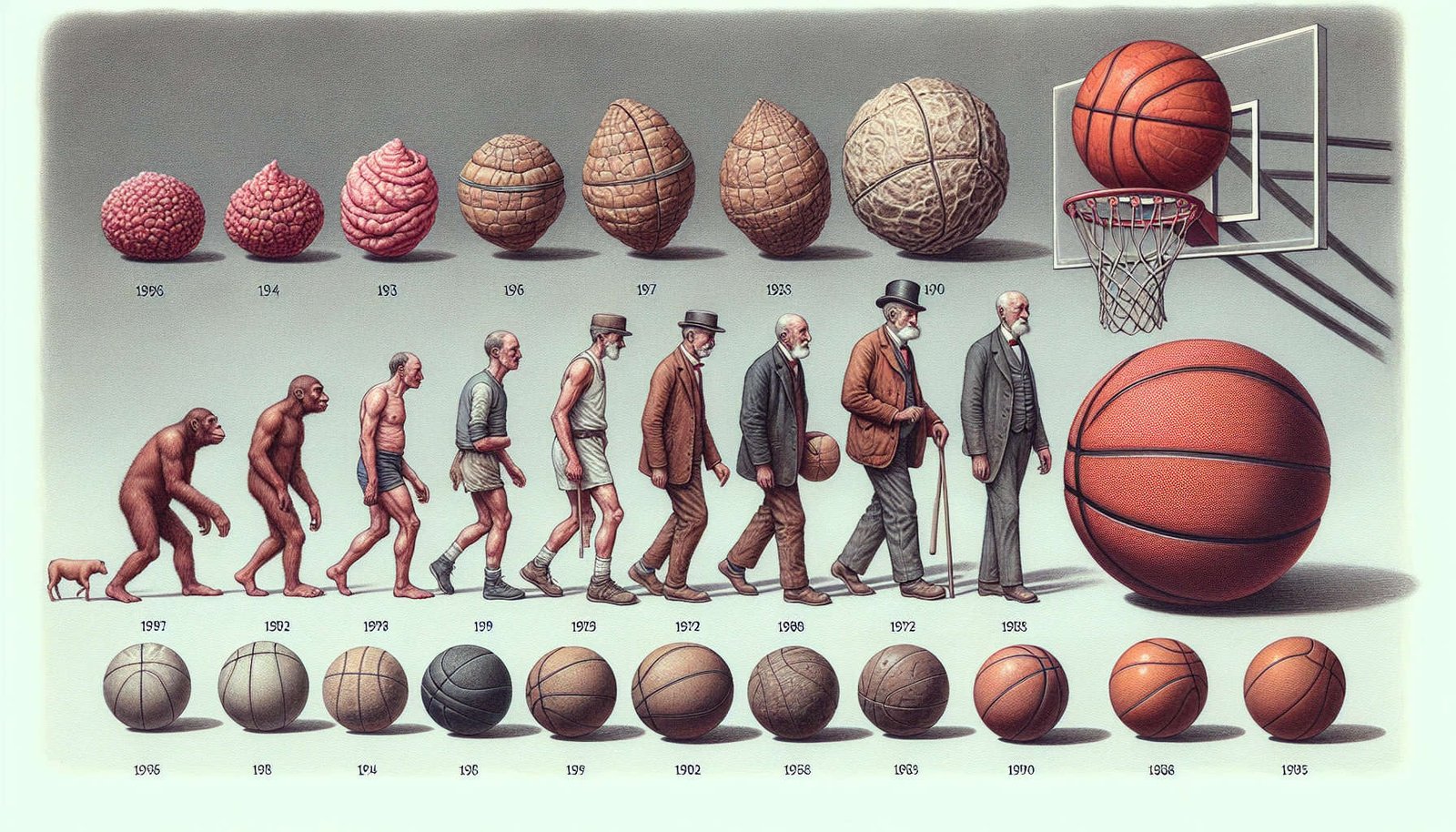Imagine playing basketball with a ball made of leather stitched together, bouncing and shooting on an outdoor court. Now picture yourself on a modern court with a sleek, synthetic ball that effortlessly glides through the air. Basketball has come a long way since its early days, and so have the materials used to make the quintessential element of the game – the basketball itself. In this article, we’ll explore the fascinating evolution of basketball materials, comparing the old-school designs to the high-tech wonders of today. Get ready to discover the remarkable advancements that have taken basketball to thrilling new heights!
Early Basketball Materials
Introduction to early basketballs
Early basketballs were made using different materials compared to today’s basketballs. These materials played a crucial role in shaping the game and its evolution. The early basketballs were primarily composed of leather, which was the most common material used during that time. However, with advancements in technology and the need for improved performance, materials such as rubber and specialized coatings have been introduced in modern basketballs.
Invention of the basketball
The invention of basketball can be traced back to Dr. James Naismith, who created the game in 1891. Initially, the basketballs used were not as standardized as they are today. In fact, the first basketballs were not even made specifically for the game. Instead, soccer balls were used and adapted for basketball, making the early basketballs larger and heavier compared to today’s standard.
Materials used in early basketballs
Leather was the primary material used in early basketballs. It provided several benefits such as durability, grip, and a consistent bounce. Leather basketballs were hand-stitched and filled with various materials like straw, rubber, or animal bladder. This combination gave the early basketballs their distinct feel and characteristics.
Leather
Benefits of leather in early basketballs
Leather offered numerous advantages in early basketballs. Its natural texture provided excellent grip, allowing players to have better control over the ball. Moreover, leather had a consistent bounce, ensuring a more predictable trajectory during gameplay. Additionally, leather basketballs had a soft feel, making them comfortable to handle and reducing the risk of injury.
Drawbacks of leather in early basketballs
Despite its advantages, leather also had some drawbacks in early basketballs. One significant limitation was the susceptibility to damage from moisture. Leather basketballs would absorb water, becoming heavier and losing their bounce. Additionally, leather needed regular maintenance to keep it in optimal condition, requiring players to frequently clean and oil the balls.
Maintenance of leather basketballs
To maintain the quality of leather basketballs, players had to take extra care. Regular cleaning and oiling were necessary to keep the leather supple and prevent it from drying out. Moreover, playing on wet surfaces was discouraged, as it could significantly affect the performance of the ball. These maintenance requirements added an extra level of responsibility for players to ensure the longevity of their leather basketballs.

Rubber
Introduction of rubber in basketballs
Rubber became a significant game-changer in the world of basketball materials. It was introduced as an alternative to leather, providing a more consistent bounce and reducing the maintenance requirements of the ball. Rubber basketballs started to gain popularity in the mid-20th century, revolutionizing the game and its equipment.
Advantages of rubber in early basketballs
Rubber offered several advantages over leather in early basketballs. It provided a consistent bounce regardless of the playing conditions, making gameplay more predictable. Rubber basketballs were also more resistant to moisture, eliminating the issue of water absorption and maintaining their performance. Additionally, rubber basketballs required minimal maintenance, allowing players to focus more on the game itself.
Disadvantages of rubber in early basketballs
While rubber had its advantages, it also had some limitations in early basketballs. One drawback was the lack of grip compared to leather. Rubber basketballs were relatively smooth, resulting in a slightly slippery surface, especially when players sweated or played in humid conditions. This reduced grip could affect shooting accuracy and overall ball control for players.
Stitching Thread
Importance of stitching in early basketballs
The stitching of early basketballs played a crucial role in holding the ball together and ensuring its durability. Stitching provided the necessary reinforcement to maintain the ball’s shape during gameplay and prevent it from easily unraveling. A well-stitched basketball was considered essential for a satisfying play experience.
Materials used for stitching thread
In the early days of basketball, stitching thread was typically made of natural materials such as cotton or linen. These natural fibers were strong and durable, providing reliable stitching that could withstand the demands of the game. The quality and type of stitching thread used had a direct impact on the overall longevity of the basketball.
Impact of thread material on early basketballs
The choice of thread material had a significant impact on the performance and durability of early basketballs. High-quality stitching thread made from sturdy natural fibers ensured the longevity of the basketball, preventing it from coming apart or losing shape during intense gameplay. The strength of the thread also determined how well it could withstand the pressure and impact of bouncing and catching the ball.

Today’s Basketball Materials
Introduction to modern basketballs
Modern basketballs have come a long way in terms of materials and technology. The focus has shifted towards creating basketballs that offer optimal performance, durability, and a satisfying playing experience. Today’s basketballs are typically composed of composite leather, synthetic rubber, and feature specialized coatings.
Evolution of basketball materials
The evolution of basketball materials reflects the continuous pursuit of improving the game. From the initial use of leather and rubber, the introduction of composite leather and synthetic rubber brought significant advancements. The materials used in modern basketballs are carefully selected to enhance grip, bounce consistency, and overall durability.
Comparison with early basketballs
Compared to early basketballs, modern basketballs have overcome many limitations and offer a more standardized and reliable experience. The introduction of composite leather and synthetic rubber has addressed the drawbacks of their predecessors while incorporating innovative features. The use of specialized coatings has further enhanced grip and overall performance, allowing players to maximize their skills on the court.
Composite Leather
Advantages of composite leather in modern basketballs
Composite leather has gained popularity in modern basketballs due to its numerous advantages. It offers a superior grip, comparable to the traditional feel of leather while being more consistent across different playing conditions. Additionally, composite leather basketballs are more durable and resistant to wear and tear, ensuring a longer lifespan compared to genuine leather balls.
Disadvantages of composite leather in modern basketballs
Despite its advantages, composite leather does have a few drawbacks. One challenge is maintaining a new ball’s grip, as composite leather tends to be slightly smoother initially. However, with regular use and proper breaking-in, the grip improves over time. Additionally, composite leather basketballs may have a slightly different feel compared to traditional leather balls, which could impact players who are accustomed to the latter.
Durability of composite leather basketballs
One of the significant advantages of composite leather basketballs is their durability. The synthetic materials used in composite leather provide increased resistance to wear and tear, making the ball last longer without compromising its performance. This improved durability is a significant advantage for players who engage in rigorous training sessions or regularly play competitive basketball.

Synthetic Rubber
Benefits of synthetic rubber in modern basketballs
Synthetic rubber has become a crucial component in modern basketballs due to its numerous benefits. It offers excellent bounce consistency, allowing players to anticipate and control the trajectory of the ball accurately. Synthetic rubber basketballs are also highly resistant to moisture, ensuring consistent performance regardless of playing conditions. Moreover, synthetic rubber provides enhanced grip, enabling players to maintain better control over the ball during gameplay.
Drawbacks of synthetic rubber in modern basketballs
One drawback of synthetic rubber basketballs is the potential for slightly reduced softness compared to traditional rubber balls. While this might not be noticeable to all players, those accustomed to the feel of traditional rubber basketballs may need some adjustment. However, the performance improvements provided by synthetic rubber often outweigh this minor drawback.
Performance characteristics of synthetic rubber basketballs
Synthetic rubber basketballs excel in terms of performance characteristics. The material’s enhanced bounce and grip properties allow for better gameplay control and accuracy. The consistent bounce of synthetic rubber basketballs ensures that players can anticipate and respond effectively to the ball’s movements, ultimately improving their overall performance on the court.
Polyester Thread
Role of polyester thread in modern basketballs
Polyester thread has become the preferred choice for stitching modern basketballs due to its strength and durability. The use of polyester thread ensures that the stitching remains intact, withstanding the rigorous demands of the game. The thread plays a critical role in maintaining the ball’s shape, preventing it from unraveling or losing structural integrity during gameplay.
Advantages of polyester thread for stitching
Polyester thread offers several advantages over earlier stitching materials. It is highly resistant to moisture, reducing the risk of thread deterioration due to water absorption. Polyester thread also provides excellent tensile strength, ensuring that the stitching remains intact even under intense pressure. The durability and longevity of basketballs stitched with polyester thread make them an ideal choice for both professional and recreational players.
Comparison with earlier stitching materials
Compared to natural fibers like cotton or linen, polyester thread offers superior strength and resilience. It can withstand the intense demands of basketball gameplay, reducing the likelihood of thread breakage or unraveled seams. The introduction of polyester thread has significantly improved the quality and durability of modern basketballs, ensuring they remain in optimal condition for an extended period.

Specialized Coatings
Introduction of specialized coatings in basketballs
The introduction of specialized coatings in basketballs has further enhanced the overall performance and playing experience. These coatings are designed to improve the ball’s grip, increase its durability, and enhance its overall feel on the court. The application of specialized coatings is a testament to the constant pursuit of innovation and improvement in basketball materials.
Benefits of specialized coatings
Specialized coatings offer several benefits in modern basketballs. They provide an improved grip, allowing players to have better control and handling of the ball. Furthermore, these coatings make the basketballs more resistant to abrasion and scuffing, ensuring longevity and maintaining the balls’ appearance and performance. Additionally, specialized coatings can enhance the feel of the ball, adding an extra level of comfort and responsiveness for players.
Impact on ball grip and playing experience
The introduction of specialized coatings has had a positive impact on ball grip and the overall playing experience. The enhanced grip allows players to make precise moves, dribble effectively, and shoot with better accuracy. With improved grip, players can confidently handle the ball, reducing the risk of turnovers and improving their overall performance on the court.
Technological Innovations
Utilization of technology in modern basketballs
Modern basketballs have embraced various technological innovations to further enhance their performance and features. One notable advancement is the use of embedded sensors and smart technology in some basketballs. These technological additions offer a range of features, including tracking shot accuracy, monitoring player performance, and providing real-time feedback to players.
Smart basketballs and their features
Smart basketballs have revolutionized the game, enabling players to analyze and improve their skills efficiently. These basketballs are equipped with sensors that can track shooting accuracy, shot mechanics, and even provide coaching tips. Additionally, smart basketballs often connect to smartphone applications, allowing players to review their performance, track progress, and engage in interactive training programs.
Future advancements in basketball materials
The future of basketball materials is promising, with advancements focused on further improving performance, durability, and player experience. Innovations such as self-inflating basketballs, materials with enhanced grip, and even interactive holographic enhancements are being explored. As technology continues to evolve, it is safe to say that basketball materials will continually adapt and improve to meet the ever-changing demands of the game.


